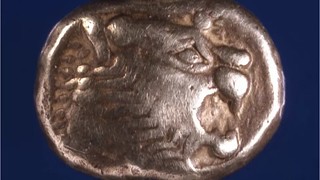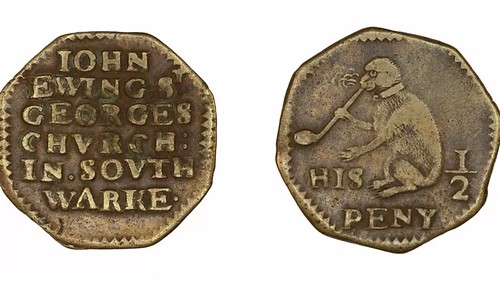
PREV ARTICLE
NEXT ARTICLE
FULL ISSUE
PREV FULL ISSUE
BRITISH MUSEUM HISTORY OF CURRENCYDick Hanscom recently came across this old BBC News article on the history of coinage from the British Museum. Here's an excerpt - see the complete article online. -Editor
This coin made from electrum - a natural alloy of gold and silver found in riverbeds - is one of the earliest examples of coins, and the beginnings of the Western tradition of coinage that is still going strong. It was minted in Lydia, in modern day western Turkey, in the 7th Century BC, making it more than 2,500 years old. These coins, featuring a lion's head, were of a consistent weight and purity. As a result, they held a value that allowed them to be used in cross-border trade - replacing the idea of two commodities effectively being swapped between traders. The tiny coin was of significant value, so was used in high-level trade, as gifts between rulers, and as payment to mercenary soldiers. The vast majority of the population would never see one, and continued to trade without coins - as had been the case for cities and empires for more than 2,000 years. Bartering, for example, still ran in parallel with trading using coins. Throughout history, coins have looked very different to the money we recognise today. This hollow-handled spade money was used in China in the early 6th Century BC, when the country was made up of a number of separate states In order to inspire confidence among the merchant classes to use this abstract concept of bronze money, it was shaped as an agricultural tool - an item recognised by these people, rather than an alien, round coin. Coins shaped as knives were also produced in China around 200 years later, as this was a shape recognised by those involved in warfare. Weight was much more important that shape in terms of value. Although its use was more widespread than the Lydian coins, the use of coins as currency did not filter down to the population at large until Roman times. Let's skip ahead to a cool token. -Editor When the British Isles were gripped by civil war in the 17th Century, there was huge instability and a lack of small denomination currency. Small traders and other establishments stepped in when the central authority was unable to provide this coinage, by issuing their own tokens. This 17th Century token was issued, according to the inscription, by John Ewing, who traded near St George's Church in Southwark. He was a tobacconist, hence the image of a monkey smoking a pipe. Customers could use this token in his store, but other local traders may have accepted it, too. This private production of money was in many ways a forerunner to local currencies seen today such as the Brixton Pound and the Bristol Pound, as well as cryptocurrencies or digital currency such as Bitcoin. However, these tokens were not used for long. A Royal proclamation, following the restoration of the English monarchy in 1660, clamped down on their production.
To read the complete article, see:
Wayne Homren, Editor The Numismatic Bibliomania Society is a non-profit organization promoting numismatic literature. See our web site at coinbooks.org. To submit items for publication in The E-Sylum, write to the Editor at this address: whomren@gmail.com To subscribe go to: https://my.binhost.com/lists/listinfo/esylum All Rights Reserved. NBS Home Page Contact the NBS webmaster 
|



